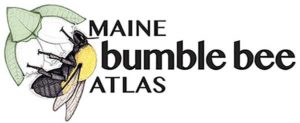 |
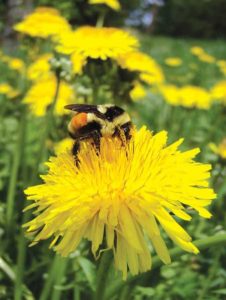 |
| Orange-belted Bumble Bee (Bombus ternarius) on a dandelion. Photo by Leif Richardson |
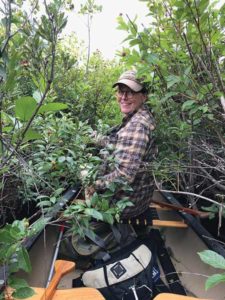 |
| Selene Frohmberg looking for bumble bees from the bow of a canoe. Photo by Eric Frohmberg |
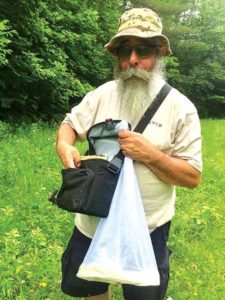 |
| Eric Frohmberg with his bee collecting kit. Photo courtesy of the Frohmbergs |
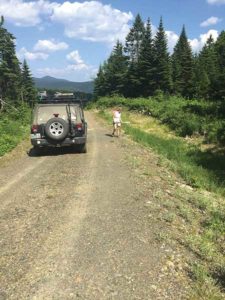 |
| Selene Frohmberg collecting in a remote area. Photo by Eric Frohmberg |
By Tim King
On a recent camping trip to Lake Umbazooksus, Eric Frohmberg woke early and discovered that a Fernald’s cuckoo bumble bee had spent the night on a flower right by the water. Cuckoo bumble bees, like their avian namesakes, lay their eggs in the nests of other bumble bee species, Frohmberg explains.
“It was on a trip with the family to see the abandoned train engines in the North Maine woods,” he said. “We were camping right next to Umbazooksus, and I woke up in the morning to find the bee having spent the night in a flower right by the water. It was one of those glorious moments – fog on the water just burning off. Everyone else asleep. Felt like I had the whole state of Maine to myself.”
Eric, along with his wife, Selene Frohmberg, are part of a team of volunteers and scientists who have been gathering data on the distribution of bumble bees in Maine since 2015. The project is called the Maine Bumble Bee Atlas.
Critical Pollinators in Decline
Bumble bees are critical pollinators for Maine’s blueberry crop and for many other domestic fruit and vegetable crops. They also pollinate an unknown number of wildflower species. Beginning at the end of the last century, biologists began to realize two things about them: Some species of bumble bees were in decline, and biologists didn’t know much about bumble bees.
“There are 46 species of bumble bees (Bombus spp.) found in North America, 18 of which have been documented to occur in Maine,” wrote the authors of the “Maine Bumble Bee Atlas Participant Handbook.” “Of these, three have experienced dramatic reductions in number and range: the Rusty-patched Bumble Bee (Bombus affinis), the American Bumble Bee (Bombus pensylvanicus), and the Yellow-banded Bumble Bee (Bombus terricola). A fourth species, Ashton’s Cuckoo Bumble Bee (Bombus ashtoni), has not been found in over a decade and is possibly extirpated from Maine, although it still persists in other parts of its range. About half the remaining 14 species are believed to be stable or increasing in Maine, while the other half are of unknown status. Because a comprehensive statewide survey of Maine’s bumble bee fauna has never been conducted, very little is known about the historic or current distribution and abundance of individual Bombus species. Without this information we do not have the ability to confidently assess their current or future status and trends in the face of regional and range-wide conservation concerns.”
Filling the Knowledge Gap
In 2015, citing their limited knowledge, the Maine Department of Inland Fisheries and Wildlife (MDIFW) in partnership with the University of Maine at Orono and Farmington launched the Maine Bumble Bee Atlas (MBBA). This new project was modeled after MDIFW’s Maine Butterfly Survey (2007-2015) and Maine Damselfly and Dragonfly Survey (1999-2005). All three previous projects asked volunteers to gather a large amount of data on the three groups of insects. For the atlas, volunteers again stepped forward to help gather data on Maine bumble bees. Some of the people who volunteered for the MBBA were veterans of the previous surveys, according to Beth Swartz, a project coordinator and biologist with MDIFW.
“Across the board, our citizen science volunteers are genuinely interested in nature, have strong conservation values, are eager to learn and are enthusiastic and grateful about having an opportunity to personally contribute data that plays a role in conservation,” she said. “One of my favorite parts of the training workshops was always the introductions, when we asked everyone to tell us something about who they are and why they were interested in participating in MBBA. Our volunteers come from all walks of life – bankers, teachers, lawyers, students, conservation professionals, business people, artists, engineers – you name it!”
One of the volunteers was Beth Chagrasulis, a secondary school teacher. She had multiple reasons for volunteering.
“I am a life sciences instructor at Bridgton Academy in North Bridgton, where I teach a variety of courses, including nutrition, genetics and medical microbiology,” she said. “This project, however, combined multiple interests for me. First, it was happening right here in my home state of Maine. Second, it gave me an opportunity to volunteer and contribute to a real science effort. Also, I am fascinated by all animals, including arthropods (bees are arthropods), and have always liked bumble bees. Who doesn’t?! I really enjoyed taking entomology as an undergrad, and as a science teacher it was a good way to be a role model for my students. The opportunities to contribute to citizen science are growing year to year, including some projects that can be done simply sitting at a computer. I encouraged the students to take a look at the choices and consider volunteering in the future.”
The project organizers trained volunteers in a daylong workshop how to observe bumble bees, record the data and get that data to their scientist-partners so that they could build the atlas. Half of the workshop introduced the project and its goals and the basics of bumble bee biology and conservation. The second half focused on project methods and protocols. “That included a lab session instructing them how to pin their vouchers [collected and preserved specimens] and distributing the equipment they would need,” said Swartz. “Weather permitting, we also included a field session to demonstrate and practice survey methods with real bumble bees.”
Volunteers learned how to euthanize bees because bumble bee species are difficult to identify and a microscope is often needed to do the job. However, volunteers who didn’t want to collect and euthanize bumble bees were encouraged to photograph them. The organizers trained all participants to identify the federally endangered rusty-patched bumble bee and to never euthanize them. They also discouraged participants from collecting queens in order to allow colonies to survive.
Chagrasulis said the training expanded her knowledge and curiosity about the natural world.
“In addition to learning about the different species of the bees and the native plants, I also learned a lot about bee behavior,” she said. “First, we all know there are bees pollinating plants, but I had no idea how many different species of just bumble bees there were, not to mention all the other types of bees, flies, wasps and more that are out there, too.”
Eric Frohmberg, who studied entomology in college, also said he enjoyed learning about bumble bee biology and about how to collect and preserve bees and the data associated with them.
“The collection of the bees is useless without the data that goes along with them,” he said.
Frohmberg and Chagrasulis approached collecting bees and data with dedication and persistence. For example, at her collection sites in Cumberland County in 2017, Chagrasulis, in partnership with her dog, Buddy, collected 22 spotted bumble bees, three-brown belted bumble bees, 39 common eastern bumble bees, two confusing bumble bees and 11 tri-colored bumble bees. To collect this trove of data, she visited her collection sites 16 times from May through October. Those sites included different habitats, such as a blueberry farm and a wetland near her home and within 25 miles of each other. That helped her visit them frequently, as did the sense that she was doing something useful.
“I think, just like anything, something you ‘have’ to do can seem like a chore when time is short,” she said. “But once I was out there, it was enjoyable. I think I looked forward to it more in order to fulfill my commitment to the project rather than a fun outing. You had to have something to write with, and the collection vials with the voucher numbers, and a cooler with ice, and the weather had to be just right or the bees wouldn’t be out – so it wasn’t as if I was a fairy tale character skipping into nature with a basket of sandwiches. It was science.”
The team intended to stop collecting data in 2019 but decided to continue in 2020 to gather data in remote areas of Maine that had not been visited by volunteers.
“In this additional year, if I can get to one or more of the towns on the map where there is a need, I’ll collect there instead of my usual places,” Chagrasulis said.
The emphasis on remote locations for 2020 fit the Frohmbergs’ collection strategies from previous years to a tee.
“We mostly try new spots,” Eric said. “Or spots that require more sampling. We use the maps provided by the project to identify townships that have not been sampled, and then find a way to get there. Generally speaking, the more remote or obscure, the better. We try to collect areas that are not likely to be collected by others. They are, for example, areas that are away from major roads or accessible only by canoe.”
The Frohmbergs both enjoy trout fishing, so a bumble bee collection outing may turn into a trout fishing adventure and a night in the woods.
“I remember finding one spot with little wild brook trout that were so enthusiastic about taking our flies that their enthusiasm rubbed off on us!” said Eric, who records a podcast called “Angler’s Entomology.”
“This year we are planning to canoe the Allagash with our family. We’ve gotten permission through the state to collect along the waterway and are hoping to get some good data.”
Learning from Modern Records
Good data gathered by Chagrasulis, the Frohmbergs and several hundred other dedicated Maine volunteers has impacted the understanding of the status and distribution of bumble bees in Maine profoundly. The MBBA website has a page (https://mainebumblebeeatlas.umf.maine.edu/me-bumble-bees/distribution-by-town/) for records of observations for each species of bumble bee that has been observed in Maine. The records are broken down into observations before and after the year 2000. The post-2000 records are primarily those of the atlas volunteers. If you simply looked at the pre-2000 records, you would believe that the Fernald’s cuckoo bumble bee that Eric Frohmberg saw on the banks of Umbazooksus could be found only in three Maine townships. The modern records, gathered by atlas volunteers, show it widely spread across the state in more than two dozen townships.
In the case of the two-spotted bumble bee, no pre-2000 records exist, but atlas volunteers concentrated in the southern townships of the state made dozens after that.
Although pre-2000 records list the indiscriminate cuckoo bumble bee, atlas volunteers were unable to find any of them. About a dozen historical records exist of the federally endangered rusty-patched bumble bee, mostly in the coastal south. Two post-2000 records were made before the MBBA started. None have been recorded since 2009.
However, an MBBA volunteer did collect Ashton’s cuckoo bumble bee in Aroostook County two years in a row. That species is a nest parasite of the rusty-patched bumble bee. As the rusty-patched bumble bee declined, so did the Ashton’s cuckoo.
“This was the first time this species, which has declined dramatically throughout its range, has been documented in Maine since the mid-‘90s,” Swartz said. “People were very excited about this!”
One reason the Ashton’s cuckoo bumble bee is doing well in Maine is because atlas volunteers documented a few hundred observations of the yellow-banded bumble bee across the state all five years of the program, according to Swartz. Ashton’s cuckoo also parasitizes nests of that bee.
“The yellow-banded bumble bee has declined significantly in many parts of its range and did experience a decline in Maine in the late ‘90s and early 2000s,” Swartz said. “It recently underwent a status review by the U.S. Fish and Wildlife Service to determine if it warranted federal listing, and MBBA data played a big role in the data contributed from Maine for that process.”
“We’ve been able to significantly increase the number of confirmed records for many species, fill in large gaps in our knowledge of distribution, and compare the relative abundance of individual species in the collections – all of which tell us something about a species’ status in Maine,” Chagrasulis said.
An Enriching Volunteer Experience
Both Chagrasulis and Eric Frohmberg say they have been enriched personally by their participation in the Maine Bumble Bee Atlas. They also feel that they’ve contributed to bumble bee conservation.
“It’s important to remember that these aren’t just collected bees,” Frohmberg said. “It is all the data that goes along with them, both the data we volunteers collect as well as the genetic data within the bees themselves, that will be hugely valuable for future researchers.”
They also believe that by volunteering, citizens gain a deeper understanding of how government and science work.
“I would like to invite your readers and all people to volunteer for citizen science efforts,” Chagrasulis said. “Maybe if more people participated in ‘doing’ science, there would not be this baffling phenomenon of people not believing in science. I don’t understand! Science is not a belief.”
The results of Chagrasulis, the Frohmbergs and all the other Maine citizens who worked together to create the Maine Bumble Bee Atlas appear at https://mainebumblebeeatlas.umf.maine.edu. Swartz and her colleagues at MDIFW are still compiling data, so visit often to continue to learn about Maine’s amazing pollinators.
If you’re interested in other citizen science programs in Maine, visit the MDIFW’s Citizen Science Portal at https://www.maine.gov/ifw/fish-wildlife/citizen-science-projects.html.
About the author: Tim King is a produce and sheep farmer, a journalist, and cofounder of a bilingual community newsletter. He lives near Long Prairie, Minnesota.
